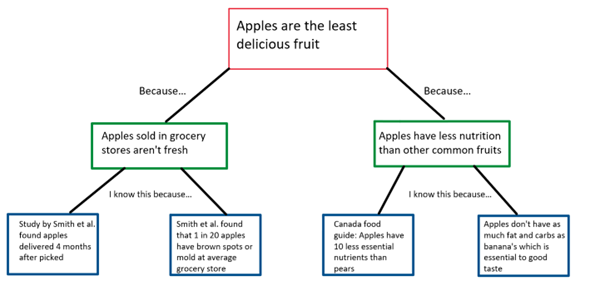Once you have your ideas, you can think about organizing these in a way that answers your writing prompt or supports your overall opinion (i.e. thesis).
Developing a Thesis
First confirm if your essay needs a thesis; some papers (i.e. reflections) do not require a thesis (an overall claim). If your professor is asking you to give an opinion on a topic, you will likely need to develop a thesis.
You do not need a perfect thesis before you start writing. Remember the writing process is a learning process and your opinion may change as you become more familiar with the topic.
Developing a thesis is a process of narrowing your opinion. One way you can do this is by explaining your purpose and asking yourself “What do I mean?” This can help you be more specific with your opinion.
Example
Purpose: to identify the major issues, trends, and breakthroughs about illiteracy in Canadian prisons in comparison to the United States.
What do I mean? - Issues and trends such as increasing/decreasing illiteracy rates or experimental teaching methods; breakthroughs such as decreased school drop-outs, increase in remediation programs, increase in volunteer tutors in the prison system
What I really mean is…. And the process continues!
Researching
After the brainstorming stage, you should have a better idea of what you know and what you don’t know about the topic. This will help direct you regarding what resources you need to find to gain a better understanding of the topic or answer questions you have.
When writing academic essays, you want to ensure that you are using reliable and valuable resources. You can assess the quality of your sources using the CRAAP test. BROKEN LINK You can use the CRAAP Checklist when reviewing your sources.
The University of Toronto also has online Essential Research Skills Modules (open access) and many research guides which you can use to learn more about research and to further develop your skills.
| Currency | The timeliness of the information |
| Relevance | The usefulness of the information for your needs |
| Authority | The source of the information |
| Accuracy | The reliability, truthfulness, and correctness of the information |
| Purpose | The reason the information exists |
Arranging Your Arguments/Ideas
- If explaining a process, it may make sense to arrange your argument chronologically.
- Your reader may need certain arguments to be explained first for other arguments to make sense.
- It is okay to reorganize as you go.
Linear Outline Example
With linear outlines, you can paraphrase or use full sentences. This can be done by writing, typing or dictating your thoughts. If you like using the outline method for note taking, this method could work well for you as well. You can find a template for this in the Template Section below.
Example
Thesis/Claim: What is my opinion?
Introduction: What background knowledge does the reader need?
- Definition of what social media is and isn’t
- Basic communication features of Twitter (upvoting, retweets)
Argument 1: What is the idea that supports your thesis?
- Evidence/Support: What is the evidence supports this idea?
-
- Tweets that are upvoted are the ones we see the most often.
-
Graphic Outline Example
